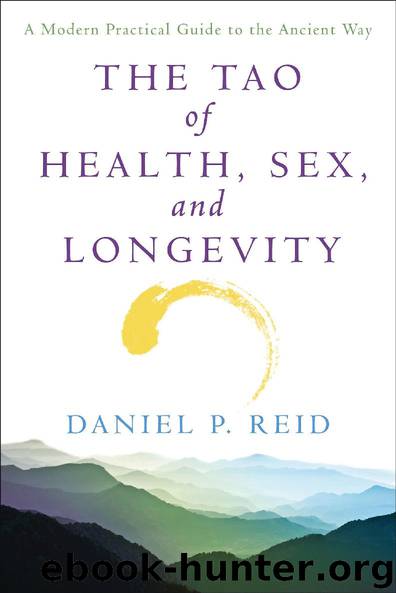The Tao Of Health, Sex, and Longevity by Daniel Reid

Author:Daniel Reid
Language: eng
Format: epub
Publisher: Touchstone
The Martial Arts
What Westerners often fail to grasp about Chinese martial arts is that their primary purpose is to serve as defense against disease and degeneration, not against bullies and bandits, and that they are based upon precisely the same forces that lie at the heart of medicine, meditation, and all Taoist arts. This point is well put in The Wandering Taoist :
Learning martial arts means self-assurance, not arrogance. It is not the boxer who is dangerous, rather, it is the weakling. Insecure, the latter must constantly “prove” himself.
As master martial artist Hung Yi-hsiang of Taipei says, “The best fighters never have to fight!”
To Taoists, the martial arts are simply the Yang complement to the Yin arts of medicine and nutrition, and the active physical complement to the passive spiritual arts of meditation. From the point of view of the Three Treasures, the medical/nutritional arts nourish essence, the martial arts “martial” energy, and the meditative arts cultivate spirit.
The fusion of body and breath in exercise is traditionally attributed to the Buddhist monk Bodhidharma (Ta Mo), who arrived in China from India during the 5th century AD. In addition to Buddhist scriptures, Bodhidharma introduced yoga and pranayama breathing to China. The resulting blend of indigenous Chinese dao-yin animal forms with the yoga and rhythmic breathing brought from India by Bodhidharma gave birth to the Chinese martial arts as we know them today.
The indivisibility of the Three Treasures is the key that links the medical, martial, and meditative arts in Taoist tradition. All three aspects support and complement one another and approach the same goal of harmony and balance from different angles. In China, most masters of the martial arts study and practice traditional Chinese medicine and devote time to the cultivation of spirit through meditation. Most Chinese physicians also practice soft-style exercises and deep breathing, and Taoist mystics keep their bodies in shape by practicing martial arts and taking medicinal herbs. As with everything else in Taoism, exercise is a package deal in which the total is greater than the sum of its parts. It cannot be fragmented into parts without losing its therapeutic benefits.
Bodhidharma ended up at the famous Shaolin Temple in central China. Part of his program was to get the Chinese monks there back into physical shape, for they were all cramped and half crippled from prolonged meditation in Lotus without any exercise. Though Buddhist, Bodhidharma was deeply influenced by Chinese Taoism, and to this day he remains the patron saint of the martial arts in China, Korea, and Japan. His glum, scowling face with his big, penetrating eyes and perpetual five o’clock shadow remains a favorite theme in traditional scroll paintings.
In order to learn the traditional martial arts forms of China, especially the subtle internal schools, such as Tai Chi (Form of the Supreme Ultimate), Ba-Gua (Form of the Eight Trigrams), and Hsing-Yi (Form of Mind), personal guidance from a qualified master is an absolute necessity. However, you may learn some of the various soft-style exercises associated
Download
This site does not store any files on its server. We only index and link to content provided by other sites. Please contact the content providers to delete copyright contents if any and email us, we'll remove relevant links or contents immediately.
| Acupuncture & Acupressure | Aromatherapy |
| Ayurveda | Chelation |
| Chinese Medicine | Energy Healing |
| Healing | Herbal Remedies |
| Holistic | Homeopathy |
| Hypnotherapy | Massage |
| Meditation | Naturopathy |
| Reference |
Inner Engineering: A Yogi's Guide to Joy by Sadhguru(6725)
The Power of Now: A Guide to Spiritual Enlightenment by Eckhart Tolle(5605)
Fear by Osho(4660)
Ikigai by Héctor García & Francesc Miralles(4125)
The Art of Happiness by The Dalai Lama(4063)
The Ultimate Bodybuilding Cookbook by Kendall Lou Schmidt(3885)
Yoga Therapy by Mark Stephens(3702)
The Little Book of Hygge by Meik Wiking(3647)
The Healing Self by Deepak Chopra(3474)
Why Buddhism is True by Robert Wright(3404)
Being Aware of Being Aware by Rupert Spira(3229)
The Hatha Yoga Pradipika (Translated) by Svatmarama(3229)
Shift into Freedom by Loch Kelly(3134)
Wild Words from Wild Women by Stephens Autumn(3092)
Work Clean by Dan Charnas(3048)
Happiness by Matthieu Ricard(2990)
More Language of Letting Go: 366 New Daily Meditations by Melody Beattie(2966)
Yoga Body & Mind Handbook by Jasmine Tarkeshi(2835)
Why I Am Not a Feminist by Jessa Crispin(2695)
